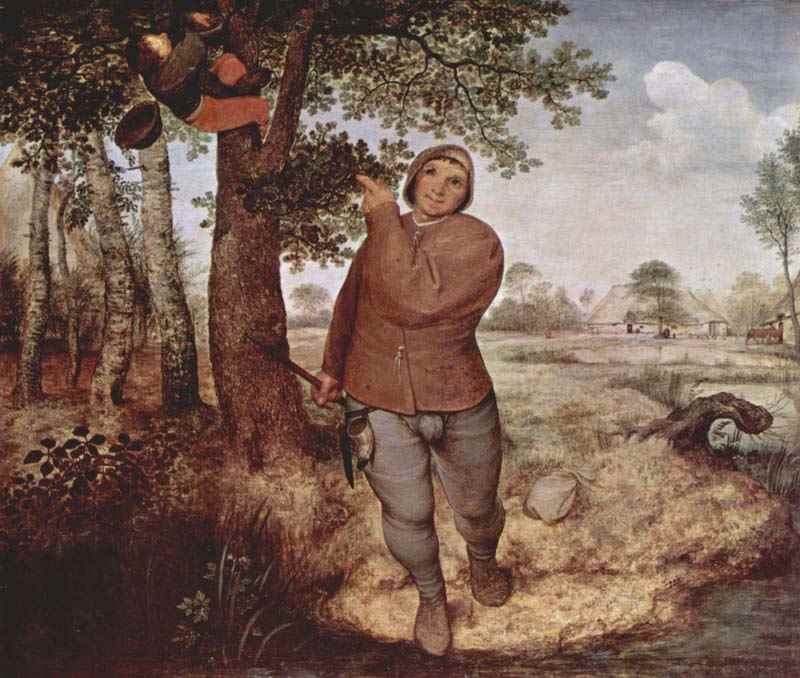
The Peasant and the Nest Robber. Pieter Bruegel the Elder.
1568, oil on wood, 59 × 68 cm
Vienna, Kunsthistorisches Museum
---
Nestausnehmer. Pieter Bruegel d. Ä.
1568, Öl auf Holz, 59 × 68 cm
Wien, Kunsthistorisches Museum
Stil: Renaissance
----
. Πήτερ Μπρίγκελ ο πρεσβύτερος
---
The Peasant and the Nest Robber (also The Peasant and the Birdnester) is an oil-on-panel by Flemish renaissance artist Pieter Bruegel the Elder, painted in 1568. It is currently held and exhibited at the Kunsthistorisches Museum in Vienna.
Description
This painting was in the collections of since 1569; passed on to the imperial collection, it became part of those of the Kunsthistorisches Museum at its inauguration.[1] Painted the year before the artist's death, this painting, like other late work such as The Land of Cockaigne, The Peasant Dance, and The Peasant Wedding, is dominated by monumental figures. Immediately after his return from Italy, Bruegel showed no apparent interest in Italian figure types and compositions, reverting to the Antwerp tradition in which he had been trained.[2] However, in these late works he shows that his study of Italian painting had taken root: these figures demonstrate his knowledge of Italian art and in particular the art of Michelangelo.[3]
St John the Baptist, by Leonardo da Vinci, 1513-16.
Detail of the Nest Robber
This unusual subject apparently illustrates a Netherlandish proverb:
Die das Nest wissen, wissen es, die es rauben, haben es.
He who knows where the nest is, has the knowledge, he who robs, has the nest.[4]
The painting presents a moralising contrast between the active, wicked individual and the passive man who is virtuous in spite of adversity[5] (a similar theme appears in his drawing The Beekeepers)[6]
It has been suggested that, with his knowledge of Italian art, Bruegel intended the peasant's gesture as a profane parody of the gesture of Leonardo's St John see image at left.[7]
References
For a short time it also became part of Napoleon's war booty.
Cf. Pietro Allegretti, Brueghel, Skira, Milano 2003. ISBN 0-00-001088-X (Italian)
Cf. Pietro Allegretti, Brueghel, ibid. (Italian)
Cf. R. Rucker, "Notes for Ortelius and Bruegel" (2011), p.55
Another interpretation could be that "the pushy guy gets the girl", as according to some "nest" in Flemish may mean "pussy". Cf. R. Rucker, "Notes for Ortelius and Bruegel" , ibid. [1]
Currently at the Kupferstichkabinett in Berlin.
F. Grossmann, Pieter Bruegel: Complete Edition of the Paintings (3rd ed.), London:Phaidon (1973), s.v.
External links
The Peasant and the Nest Robber at the KHM (German)
Notes on the painting, on Frammenti d'Arte Accessed 4 February 2012 (Italian)
Kunsthistorisches Museum's Official Website
Bosch Bruegel Society
99 works by Pieter Bruegel the Elder
Creative Bruegel laid the foundation of the Netherlands School (Russian)
"Bruegel". Encyclopedia Americana. 1920.
----
Fine Art Prints | Greeting Cards | Phone Cases | Lifestyle | Face Masks | Men's , Women' Apparel | Home Decor | jigsaw puzzles | Notebooks | Tapestries | ...
----
Retrieved from "http://en.wikipedia.org/"
All text is available under the terms of the GNU Free Documentation License


